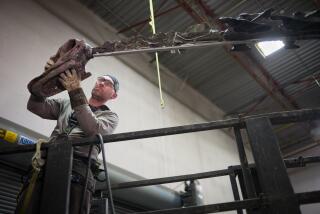Father and Son Discover New Dinosaur
- Share via
ALBUQUERQUE, N.M. — Fossils discovered in western New Mexico are believed to be from the oldest horned dinosaur ever found and could help fill in a 15-million- to 20-million-year gap in the lives and times of dinosaurs in North America.
The new species of dinosaur--possibly a distant relative of Triceratops, the sick fellow in the movie “Jurassic Park”--lived about 90 million years ago.
“It’s really a significant discovery, and it will be even more fantastic when they find more of it,” said Ken Carpenter, dinosaur paleontologist at the Denver Museum of Natural History.
Doug Wolfe, an adjunct curator at Mesa Southwest Museum in Arizona, and his son Christopher, 7, found a brow horn from a ceratopsian, or horned dinosaur, last year near Quemado in west-central New Mexico.
That find and others from the desert badlands site were announced last month in Phoenix.
The earliest known dinosaurs appeared more than 200 million years ago, but paleontologists believe the brow horn and other fossils yielded by the New Mexico site could fill in missing data from the Turonian age of the mid- to late-Cretaceous period.
“It’s the first Turonian beds in North America that have ever produced dinosaur skeletons,” said Jim Kirkland of Fruita, Colo., senior paleontologist for the Dinamation International Society.
Wolfe said in a recent interview that he and his son discovered the tip of the horn Nov. 11, 1996, weathered out of a slope.
They later found the base of the horn, the brow, part of the animal’s jaws and the base of its brain case, some teeth, an arm bone and a shoulder blade fragment.
Kirkland theorizes that the primitive three-horned ceratopsian was 10 to 12 feet long, 300 to 500 pounds and lived 90 million to 92 million years ago.
“It’s going to be a cute dinosaur. In a lot of ways, it’s going to look like a baby Triceratops, except a more primitive one,” said Kirkland, who confirmed the horn as ceratopsian, a finding supported by Carpenter.
Triceratops, which roamed Earth 65 million years ago, was 35 feet long and weighed up to seven tons, Kirkland said.
The closest relative to the new ceratopsian probably is Turanoceratops, bits of which were discovered in 1989 in the Uzbekistan desert by Lev Nessov, a Russian paleontologist.
Wolfe said the Turanoceratops, which had been believed to be the oldest horned dinosaur ever found, was several million years younger than the one he and his son discovered.
“Our animal looks to be a bit more primitive than that one, but not much older,” Kirkland said. “We’re naming the [new] species for Christopher.”
Today at the site, pinon and juniper trees keep company with eerie, pillowy rock formations and mesas where a flood plain lay 90 million years ago.
“Most cretaceous rocks are marine in character during this time,” Wolfe said. “There are very few terrestrial deposits. There are some in Morocco. There may be some in Argentina. There are probably some that are nearly equivalent in China and eastern Russia.
“But there’s nothing I’m aware of that is exactly the same age and nothing I’m aware of that has shown as complete material as what we have,” said Wolfe.
At the site along the New Mexico-Arizona border, a sea apparently had withdrawn from Arizona and sediment had washed down from Arizona’s Mogollon highlands, burying trees along with bones from various dinosaurs.
Kirkland, with Wolfe, found the first fossils in the area--a rib and a piece from an armored dinosaur--during a 1983 paleontological survey for the Museum of Northern Arizona.
Kirkland said evidence of new duck-billed dinosaurs, new crocodiles, new turtles--maybe a dozen new dinosaurs--has turned up at the site.
And this year’s discovery of a snout and other bones appears to be from a smaller cousin of that famous kick-boxing star of “Jurassic Park”--velociraptor.
“This is the most complete individual skeleton of one of these guys ever found,” said Kirkland.
Bob Denton, a contract research scientist who lives in Winchester, Va., and works in Chandler, Ariz., found the snout May 31.
“I became so overcome with emotion that I literally had to put it down for fear of dropping it,” Denton said.
Since then, about 30% of the animal’s skeleton has been found, including limb, tail, feet, hand and shoulder bones and lots of vertebrae.
The animal is a member of the dromaeosaurid family--raptors that include the velociraptorines and the dromaeosaurines, Kirkland said.
It should look very much like a dromaeosaur--about 4 1/2 feet tall, 150 pounds, he said.
But dromaeosaurs lived about 75 million years ago. The New Mexico kind lived around 91 million to 92 million years ago, Kirkland said.
More to Read
Sign up for Essential California
The most important California stories and recommendations in your inbox every morning.
You may occasionally receive promotional content from the Los Angeles Times.













